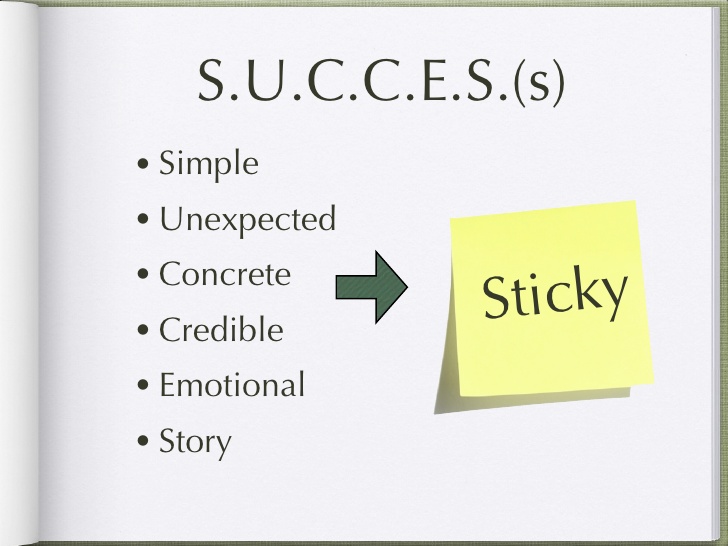Click here to return to Blog Post Intro
Try These 6 Principles:

Chip & Dan Heath coined an acronym (maybe that’s why it resonated with us at NASA!) for their principles: SUCCESs. Keep it simple (simplicity), provide surprises to help people to pay attention (unexpectedness); make sure they understand & remember (concreteness); believe & agree in your message (credibility); care about your message and your audience (emotion); and give them a way to act (stories). The power of the Made to Stick approach is how their six principles of stickiness interact with each other. No idea needs to satisfy all six principles, but the more the better; and when two or more principles come together in one idea, they reinforce each other, multiplying the stickiness factor.
Simplicity
People tend to shy away from simplicity. After all, in university settings, the more verbose, the more “educated” you sound. As a result, simple messages are often seen as inferior or dumb—the opposite of complex (better, more, superior, smart), when the reality couldn’t be further from the truth. In messaging, simple is opposed not to complexity but to complication, or the “clutter” that stands between us and an idea.
To keep your message simple, find the core…the single most important thing. In the military, this would be the “Commander’s Intent.” Soldiers need to know what their Commander intends, so they can make real-time decisions based on that intent in the field. Simple messaging focuses on the core and is compact. For example, proverbs—or profound sound bites—often stick with audiences.
Unexpectedness
An unexpected message or communication causes our mind to move out of its natural, preferred auto-pilot state. Psychologists see surprise as something akin to the “fight or flight” reflex. The typical expression associated with surprise – rigid body and widened eyes – signals the mind’s desire for more information. We stop still and take it all in.
In order to be truly unexpected, an idea has to break our preconceived notions. So, to get attention, surprise people…break a pattern…create a mystery…highlight a knowledge gap…use the news-teaser approach…
Concreteness
Concreteness relies not so much on the amount of detail, but on providing the right detail for the intended audience. Urban legends work well because they relate to experiences we’ve all had. The detail is drawn from our everyday experience, and helps to create a vivid, living impression in our minds.
For written messages, use the concreteness of a fable (e.g., “sour grapes”). The more hooks in your idea, the better. Help your audience find common ground at a shared level of understanding. This means setting goals in tangible terms.
Credibility
Statistics are a source of internal credibility – when used well. Boring your audience is a sure way not to see your ideas stick, and nothing bores an audience more than reams of statistics. The trick is to draw from the data a simple, concrete, possibly unexpected statement. For example, you are 25 times more likely to die by drowning than by shark attack…or, did you know that deer kill 300 times more people every year than sharks?
Help people believe. Make statistics accessible.
Emotion
No idea gets picked up and passed around unless it meets somebody’s needs. They have to care, and it’s your job to make them care. When people care about an idea, they become its greatest advocates (this is the notion of “going viral”).
So, make people care. Mother Teresa said, “If I look at one, I will act.” Charitable organizations have found that people will donate more to help “Rokia” (an individual) vs. a huge swath of Africa. Appeal to your audience’s self-interest. Address WIIFM (What’s in it for me?)…
Appeal to their identity…but you must note that not everyone will care at the same level you do!
Stories
Stories of virtually all of humanity’s triumphs, failures, and mixed blessings have been passed down from generation to generation, added to & reshaped by tellers. Stories are sticky—far more easily retained in our minds than information presented in just about any other way. We might not remember what we said to our mother on the phone last time we talked, but we can almost all remember what Goldilocks said when she tried the bears’ porridge — and what the baby bear said when he found little Goldilocks asleep in his bed.
A well-told tale draws its audience in, walking them through the events relayed and, some research suggests, actually produces in our brains the physical response we would have experiencing the events first-hand.
Stories provide inspiration and give people energy to act (e.g., Subway’s spokesperson Jared who was once 425 pounds and lost weight on a Subway-only diet).
In crafting your story, there are 3 key plots:
- Challenge: To overcome obstacles;
- Connection: To get along or reconnect; and
- Creativity: To inspire a new way of thinking
May your efforts to communicate vision or other messages stick with SUCCESs, as you shoot for the stars!

